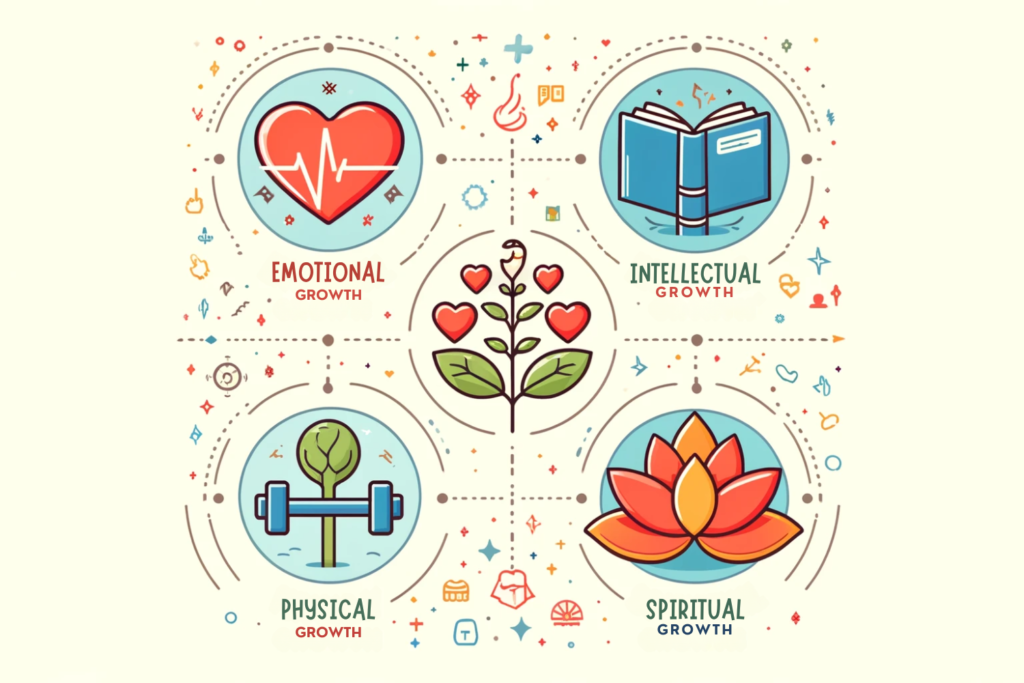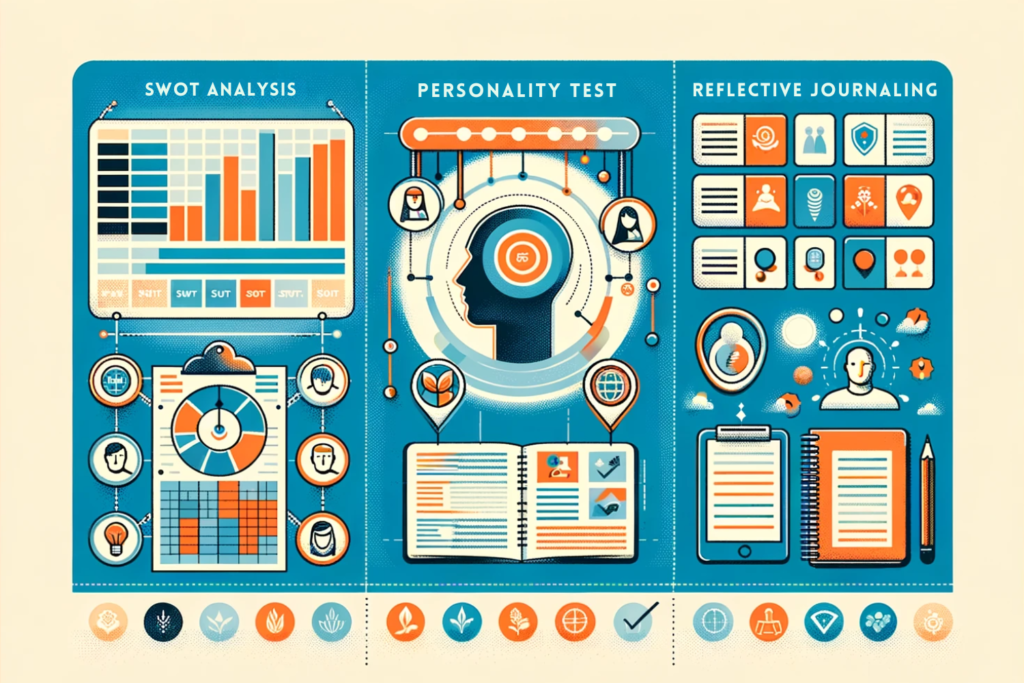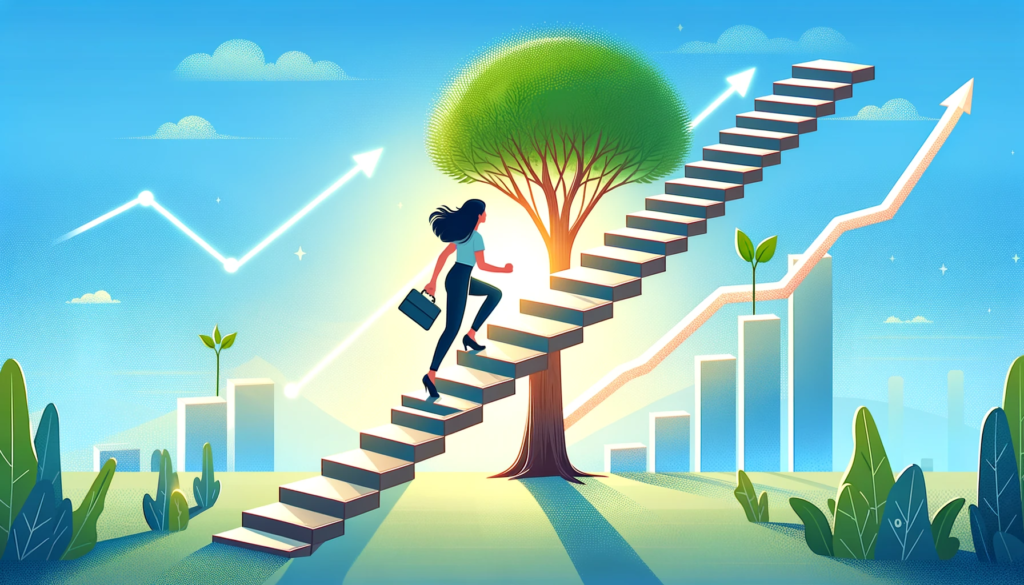Personal growth is a journey of self-discovery and transformation that involves enhancing various aspects of your life. It encompasses emotional, intellectual, physical, and spiritual development, aiming to unlock your full potential and achieve success. Personal growth is not just about setting goals and achieving them; it’s about continuous improvement and striving to become the best version of yourself.
In this comprehensive guide, we will explore the various dimensions of personal growth, provide actionable strategies, and share inspiring stories and resources to help you on your journey. Whether you’re looking to improve your emotional well-being, advance your career, or foster healthier relationships, this article will offer valuable insights and practical advice.
Key Areas of Personal Growth:
- Emotional Growth: Enhancing emotional intelligence and resilience.
- Intellectual Growth: Expanding knowledge and critical thinking skills.
- Physical Growth: Improving physical health and wellness.
- Spiritual Growth: Deepening understanding and connection with oneself and the world.
Benefits of Personal Growth:
- Increased Self-awareness: Understanding your strengths, weaknesses, and areas for improvement.
- Improved Relationships: Building stronger, more meaningful connections with others.
- Enhanced Career Opportunities: Advancing in your professional life through continuous learning and development.
Table of Contents:
- Understanding Personal Growth
- Setting the Foundation for Personal Growth
- Strategies for Personal Growth
- Tools and Techniques for Personal Development
- Enhancing Relationships for Personal Growth
- Personal Growth in Career and Professional Life
- Overcoming Obstacles in Personal Growth
- Inspirational Stories and Case Studies
- Resources for Personal Growth
By delving into these sections, you will gain a deeper understanding of what personal growth entails and how you can apply these principles to your own life. Let’s embark on this journey together, and unlock the potential within you to achieve success and fulfillment.
Understanding Personal Growth
What is Personal Growth?
Personal growth refers to the process of improving oneself through various means, including emotional, intellectual, physical, and spiritual development. It involves a commitment to self-improvement and continuous learning, with the ultimate goal of becoming a better, more fulfilled individual.
Key Areas of Personal Growth:
- Emotional Growth:
- Emotional growth focuses on enhancing your emotional intelligence, which includes self-awareness, self-regulation, motivation, empathy, and social skills.
- Developing emotional resilience helps you cope with stress and bounce back from setbacks.
- Techniques for emotional growth include mindfulness meditation, journaling, and therapy.
- Intellectual Growth:
- Intellectual growth involves expanding your knowledge, improving critical thinking skills, and fostering creativity.
- Engaging in continuous learning through reading, taking courses, and participating in discussions can significantly contribute to intellectual growth.
- Stimulating activities such as puzzles, strategy games, and intellectual debates can keep your mind sharp.
- Physical Growth:
- Physical growth is about maintaining and improving your physical health and fitness.
- Regular exercise, a balanced diet, and adequate rest are fundamental components of physical growth.
- Physical well-being can also impact other areas of personal growth, such as emotional and intellectual development.
- Spiritual Growth:
- Spiritual growth involves deepening your understanding and connection with yourself and the world around you.
- This can include exploring your values, beliefs, and purpose in life.
- Practices such as meditation, yoga, and spending time in nature can foster spiritual growth.

Benefits of Personal Growth:
- Increased Self-awareness: Personal growth helps you become more aware of your thoughts, feelings, and behaviors, leading to greater self-understanding and self-acceptance.
- Improved Relationships: By developing better communication and empathy skills, you can build stronger and more meaningful relationships with others.
- Enhanced Career Opportunities: Continuous learning and self-improvement can open doors to new career opportunities and professional growth.
- Greater Resilience: Personal growth equips you with the tools to navigate life’s challenges and setbacks more effectively.
Case Study: The Transformational Journey of Oprah Winfrey
- Oprah Winfrey’s life is a testament to the power of personal growth. From her humble beginnings, she transformed herself into a media mogul, philanthropist, and inspirational figure. Her commitment to self-improvement, education, and helping others has been a driving force in her success.
In the following sections, we will delve deeper into the specific strategies and tools that can help you embark on your personal growth journey. We will explore how to set a solid foundation for personal growth, develop effective strategies, and utilize various tools and techniques to achieve your goals.
Setting the Foundation for Personal Growth

Building a solid foundation for personal growth is crucial for sustained development and success. This chapter will guide you through self-assessment techniques, goal-setting methods, and the creation of vision boards, all of which are essential steps in establishing a strong base for your personal growth journey.
Self-Assessment Techniques
Before embarking on your personal growth journey, it’s important to understand where you currently stand. Self-assessment allows you to identify your strengths, weaknesses, and areas for improvement. Here are some effective self-assessment techniques:
- Strengths and Weaknesses Analysis:
- SWOT Analysis: SWOT stands for Strengths, Weaknesses, Opportunities, and Threats. This framework helps you evaluate your internal and external environments.
- Strengths: Identify your core competencies and skills.
- Weaknesses: Recognize areas where you need improvement.
- Opportunities: Look for external opportunities that align with your strengths.
- Threats: Be aware of external challenges that could hinder your progress.
- Example: If you excel in public speaking but struggle with time management, you can leverage your speaking skills while working on better organizing your time.
- SWOT Analysis: SWOT stands for Strengths, Weaknesses, Opportunities, and Threats. This framework helps you evaluate your internal and external environments.
- Personality Tests:
- Personality tests can provide insights into your character traits, preferences, and behaviors. Some popular tests include:
- Myers-Briggs Type Indicator (MBTI): Identifies your personality type based on preferences in four dichotomies (e.g., Introversion vs. Extraversion).
- Big Five Personality Traits: Measures five major dimensions of personality (Openness, Conscientiousness, Extraversion, Agreeableness, Neuroticism).
- StrengthsFinder: Helps identify your top strengths and how to leverage them effectively.
- Personality tests can provide insights into your character traits, preferences, and behaviors. Some popular tests include:
- Reflective Journaling:
- Keeping a journal can help you reflect on your daily experiences, thoughts, and emotions. Regular journaling allows you to track your progress, identify patterns, and gain deeper insights into your personal growth journey.
- Prompt Examples:
- What are three things I did well today?
- What challenges did I face, and how did I overcome them?
- What did I learn about myself today?
Goal Setting for Personal Growth
Setting clear, achievable goals is a fundamental step in personal growth. Effective goal setting provides direction and motivation, helping you stay focused on your development journey. Here are some strategies for setting and achieving your goals:
- SMART Goals:
- SMART is an acronym that stands for Specific, Measurable, Achievable, Relevant, and Time-bound. Setting SMART goals ensures clarity and feasibility.
- Specific: Clearly define what you want to achieve.
- Measurable: Determine how you will measure progress and success.
- Achievable: Set realistic and attainable goals.
- Relevant: Ensure your goals align with your overall vision and values.
- Time-bound: Set a deadline for achieving your goals.
- Example: Instead of setting a vague goal like “improve my fitness,” a SMART goal would be “run a 5K in under 30 minutes within three months.”
- SMART is an acronym that stands for Specific, Measurable, Achievable, Relevant, and Time-bound. Setting SMART goals ensures clarity and feasibility.
- Long-term vs Short-term Goals:
- Long-term Goals: These are objectives you aim to achieve over an extended period, typically several years. Long-term goals provide a sense of direction and purpose.
- Short-term Goals: These are smaller, more immediate objectives that act as stepping stones towards your long-term goals. Short-term goals help maintain momentum and motivation.
- Example: If your long-term goal is to become a published author, short-term goals could include writing for 30 minutes daily, completing a writing course, and submitting articles to blogs and magazines.
- Vision Boards:
- A vision board is a visual representation of your goals and aspirations. It serves as a constant reminder of what you are working towards and can be a powerful motivational tool.
- Creating a Vision Board:
- Collect images, quotes, and symbols that represent your goals and dreams.
- Arrange them on a board or digital platform.
- Place your vision board in a prominent location where you will see it regularly.
- Example: If one of your goals is to travel more, include pictures of destinations you want to visit, along with inspiring travel quotes.
- Creating a Vision Board:
- A vision board is a visual representation of your goals and aspirations. It serves as a constant reminder of what you are working towards and can be a powerful motivational tool.
Case Study: Setting and Achieving Goals – The Journey of J.K. Rowling
J.K. Rowling, the renowned author of the Harry Potter series, faced numerous rejections before achieving success. Her journey illustrates the importance of setting clear goals, staying resilient, and continually working towards personal growth. Rowling’s goal was to publish a book, and despite numerous setbacks, she persevered. Her determination and clear vision ultimately led to one of the most successful book series in history.
By thoroughly assessing your current state, setting SMART goals, and visualizing your aspirations, you create a strong foundation for personal growth. These steps will provide you with the clarity and motivation needed to embark on your journey towards self-improvement and success.
Strategies for Personal Growth

To make significant strides in personal growth, you need effective strategies that promote continuous improvement and adaptability. This chapter explores the importance of developing a growth mindset, embracing change, and committing to lifelong learning. These strategies will empower you to overcome challenges and achieve your personal and professional goals.
Developing a Growth Mindset
A growth mindset, a concept popularized by psychologist Carol Dweck, is the belief that abilities and intelligence can be developed through dedication and hard work. This mindset contrasts with a fixed mindset, which assumes that abilities are innate and unchangeable. Embracing a growth mindset is crucial for personal growth.
- Fixed Mindset vs. Growth Mindset:
- Fixed Mindset: Belief that talents and intelligence are static traits. People with a fixed mindset often avoid challenges, give up easily, and feel threatened by the success of others.Growth Mindset: Belief that abilities can be developed through effort and learning. Individuals with a growth mindset embrace challenges, persist through obstacles, and are inspired by others’ success.
- Techniques to Foster a Growth Mindset:
- Embrace Challenges: View challenges as opportunities to grow and learn. Instead of shying away from difficult tasks, approach them with curiosity and determination.
- Learn from Criticism: Constructive feedback is valuable for growth. Instead of taking criticism personally, use it to identify areas for improvement.
- Celebrate Effort, Not Just Outcomes: Acknowledge and reward the effort you put into learning and improving, regardless of the immediate results.
- Cultivate a Love of Learning: Stay curious and open to new experiences. Engage in activities that stimulate your mind and broaden your perspective.

Embracing Change and Adaptability
Change is an inevitable part of life, and how you respond to it can significantly impact your personal growth. Embracing change and developing adaptability are essential strategies for navigating life’s uncertainties.
- Overcoming Fear of Change:
- Acknowledge Your Fears: Understand that fear of change is natural. Identify specific fears and address them rationally.
- Focus on the Positives: Instead of dwelling on potential negatives, consider the opportunities and benefits that change can bring.
- Start Small: Gradual changes are easier to manage. Begin with small steps and gradually tackle more significant changes.
- Strategies to Adapt to New Situations:
- Stay Flexible: Be open to adjusting your plans and strategies as new information and circumstances arise.
- Build Resilience: Develop coping mechanisms to handle stress and setbacks. Techniques such as mindfulness meditation, exercise, and talking to a trusted friend can enhance resilience.
- Seek Support: Surround yourself with supportive individuals who can provide guidance and encouragement during times of change.
Continuous Learning
Lifelong learning is a cornerstone of personal growth. It involves a commitment to constantly expanding your knowledge and skills, which can lead to personal fulfillment and professional advancement.
- Importance of Lifelong Learning:
- Staying Relevant: In a rapidly changing world, continuous learning ensures you remain knowledgeable and competitive.
- Personal Fulfillment: Learning new things can be deeply satisfying and enrich your life.
- Enhanced Problem-Solving Skills: Acquiring new knowledge and perspectives improves your ability to tackle complex problems.
- Finding Resources for Learning:
- Books: Reading is a powerful way to gain knowledge. Choose books that challenge your thinking and introduce you to new ideas.
- Recommended Reading: “Mindset” by Carol Dweck, “The Power of Now” by Eckhart Tolle, “Atomic Habits” by James Clear.
- Online Courses: Platforms like Coursera, Udemy, and LinkedIn Learning offer a wide range of courses on various subjects.
- Workshops and Seminars: Attending workshops and seminars provides hands-on learning experiences and networking opportunities.
- Podcasts and Webinars: These are convenient ways to learn from experts while on the go.
- Books: Reading is a powerful way to gain knowledge. Choose books that challenge your thinking and introduce you to new ideas.
- Stimulating Activities:
- Puzzles and Strategy Games: Engaging in puzzles, chess, or other strategy games sharpens your mind and enhances critical thinking.
- Intellectual Debates: Participating in or listening to debates on various topics broadens your understanding and hones your argumentative skills.
- Creative Hobbies: Activities such as painting, writing, or playing a musical instrument stimulate creativity and intellectual growth.
Case Study: Embracing Change and Continuous Learning – The Journey of Malala Yousafzai
Malala Yousafzai, the youngest-ever Nobel Prize laureate, is a powerful example of personal growth through change and continuous learning. Despite facing extreme adversity, including an assassination attempt for advocating girls’ education, Malala has shown remarkable resilience and commitment to her cause. Her journey underscores the importance of embracing change and lifelong learning. Malala’s unwavering dedication to education and human rights demonstrates the profound impact that a growth mindset and adaptability can have on personal and societal progress.
By adopting a growth mindset, embracing change, and committing to continuous learning, you lay the groundwork for sustained personal growth. These strategies will equip you with the resilience and adaptability needed to navigate challenges and seize opportunities for self-improvement and success.
Tools and Techniques for Personal Development

Personal development involves the use of various tools and techniques to foster growth in different aspects of life. This chapter explores effective methods such as mindfulness meditation, time management skills, and building resilience. These tools can help you achieve greater emotional well-being, productivity, and overall life satisfaction.
Mindfulness Meditation
Mindfulness meditation is a practice that involves focusing on the present moment without judgment. It has been shown to reduce stress, improve concentration, and enhance emotional regulation.
- Benefits of Meditation:
- Reduces Stress: Mindfulness meditation lowers cortisol levels, which helps reduce stress and anxiety.
- Improves Focus: Regular practice enhances attention and concentration.
- Boosts Emotional Health: Meditation promotes emotional well-being by increasing awareness and acceptance of thoughts and feelings.
- A study published in the journal Psychiatry Research: Neuroimaging found that eight weeks of mindfulness meditation can increase the density of gray matter in brain regions associated with memory, empathy, and stress regulation (Penguin Random House Canada).
- Another study in JAMA Internal Medicine reported that mindfulness meditation can improve sleep quality and reduce insomnia symptoms (Penguin Random House Canada).
- Simple Mindfulness Exercises:
- Breathing Meditation: Focus on your breath, observing the sensation of each inhale and exhale. If your mind wanders, gently bring your focus back to your breath.
- Body Scan Meditation: Pay attention to different parts of your body, starting from your toes and moving up to your head, noticing any sensations or tension.
- Loving-Kindness Meditation: Cultivate feelings of compassion and love towards yourself and others by silently repeating phrases like “May I be happy, may I be healthy.”
Time Management Skills
Effective time management is essential for balancing personal and professional responsibilities. It helps increase productivity and reduce stress.
- Prioritization Techniques:
- Eisenhower Matrix: Categorize tasks into four quadrants based on urgency and importance. Focus on tasks that are both urgent and important.
- Quadrant 1: Urgent and important
- Quadrant 2: Important but not urgent
- Quadrant 3: Urgent but not important
- Quadrant 4: Neither urgent nor important
- ABC Method: Assign tasks a priority level (A for high priority, B for medium, C for low). Tackle ‘A’ tasks first.
- Eisenhower Matrix: Categorize tasks into four quadrants based on urgency and importance. Focus on tasks that are both urgent and important.
- Tools for Better Time Management:
- Todoist: A task management app that helps organize and prioritize tasks.Trello: A visual project management tool that uses boards, lists, and cards to manage tasks.Pomodoro Technique: Work in focused intervals (usually 25 minutes), followed by short breaks. This method improves concentration and reduces mental fatigue.

Building Resilience and Coping Mechanisms
Resilience is the ability to bounce back from adversity. Developing resilience helps you handle stress and recover from setbacks more effectively.
- Stress Management Techniques:
- Exercise: Regular physical activity reduces stress hormones and boosts mood.
- Mindfulness: Practicing mindfulness helps manage stress by promoting relaxation and awareness.
- Healthy Lifestyle: Adequate sleep, balanced nutrition, and hydration are crucial for managing stress.
- Developing Emotional Resilience:
- Positive Thinking: Focus on positive aspects of your life and practice gratitude.Social Support: Build strong relationships and seek support from friends and family.Adaptability: Be open to change and willing to adjust your plans as needed.
“Resilience is not about avoiding stress but learning how to thrive within it.”
Sheryl Sandberg
Case Study: The Role of Mindfulness in Personal Development – Jon Kabat-Zinn
Jon Kabat-Zinn, the founder of Mindfulness-Based Stress Reduction (MBSR), has significantly contributed to the popularization of mindfulness meditation in the West. His work demonstrates the profound impact of mindfulness on personal development. Kabat-Zinn’s MBSR program has helped countless individuals reduce stress, manage pain, and improve their overall well-being. His approach emphasizes the importance of living in the present moment and cultivating a non-judgmental awareness of one’s thoughts and feelings.
By incorporating tools like mindfulness meditation, effective time management techniques, and resilience-building strategies into your daily routine, you can significantly enhance your personal development journey. These practices not only improve emotional and mental well-being but also increase productivity and overall life satisfaction.
Enhancing Relationships for Personal Growth

Healthy relationships are a cornerstone of personal growth. They provide support, increase happiness, and contribute to emotional and mental well-being. This chapter delves into the importance of building healthy relationships, effective communication skills, and conflict resolution strategies.
Building Healthy Relationships
Building and maintaining healthy relationships require effort and commitment. These relationships can significantly impact your personal growth by providing emotional support and fostering a sense of belonging.
- Importance of Healthy Relationships:
- Emotional Support: Healthy relationships offer a support system that helps you navigate life’s challenges.
- Increased Happiness: Positive relationships contribute to overall happiness and life satisfaction.
- Personal Growth: Relationships provide opportunities for personal development through shared experiences and mutual learning.
- According to a study by Harvard University, people with strong social connections are happier, healthier, and live longer compared to those who are less connected (Penguin Random House Canada).
- The American Psychological Association highlights that strong relationships help reduce stress and promote mental health (Penguin Random House Canada).
- Characteristics of Healthy Relationships:
- Trust: The foundation of any strong relationship. Trust is built over time through consistent actions and honesty.
- Communication: Open and honest communication helps resolve issues and strengthens bonds.
- Respect: Mutual respect ensures that each person values the other’s feelings, thoughts, and boundaries.
- Support: Providing emotional and practical support to each other during times of need.
Effective Communication Skills
Effective communication is essential for building and maintaining healthy relationships. It involves not only expressing your thoughts and feelings clearly but also listening actively to others.
- Active Listening:
- Pay Attention: Give your full attention to the speaker and show that you are listening through nodding and verbal acknowledgments.
- Reflect and Clarify: Paraphrase what the speaker has said to ensure understanding. Ask clarifying questions if needed.
- Avoid Interrupting: Allow the speaker to finish their thoughts before responding.
- Assertive Communication:
- Expressing Needs Clearly: Communicate your needs and desires openly and directly without being aggressive or passive.
- Using “I” Statements: Use statements like “I feel…” or “I need…” to express your feelings and needs without blaming others.
- Maintaining Respect: Be respectful and considerate of the other person’s perspective.
- Instead of saying, “You never listen to me,” an assertive approach would be, “I feel unheard when I’m interrupted. Can we try to listen to each other fully?”
Conflict Resolution Strategies
Conflict is a natural part of any relationship. Learning how to handle conflicts effectively can strengthen your relationships and contribute to personal growth.
- Identifying Sources of Conflict:
- Miscommunication: Many conflicts arise from misunderstandings or misinterpretations.
- Differing Values or Beliefs: Conflicts can occur when individuals have different values, beliefs, or expectations.
- Stress and External Factors: External stressors such as work pressure or financial issues can lead to conflicts.
- Techniques for Resolving Conflicts:
- Stay Calm: Take a moment to breathe and calm down before addressing the conflict.Focus on the Issue: Address the specific issue at hand without bringing up past grievances.Find Common Ground: Identify areas of agreement and build on them to find a mutually acceptable solution.Compromise: Be willing to give and take. Finding a middle ground can often resolve conflicts more effectively.
“The quality of our lives depends not on whether or not we have conflicts,
but on how we respond to them.”
Thomas Crum
Case Study: Building and Maintaining Strong Relationships – Michelle Obama
Michelle Obama, former First Lady of the United States, is widely respected for her emphasis on the importance of family, friendship, and community. In her memoir, Becoming, she discusses the significance of strong relationships in her personal and professional life. Michelle emphasizes open communication, mutual respect, and unwavering support as the pillars of her relationships. Her commitment to fostering healthy relationships has not only contributed to her personal growth but also to her success as a public figure and advocate.
By focusing on building healthy relationships, developing effective communication skills, and learning how to resolve conflicts, you can enhance your personal growth journey. These strategies will help you build strong, supportive connections that contribute to your overall well-being and happiness.
Personal Growth in Career and Professional Life

Personal growth is not confined to personal life; it extends into your career and professional development. This chapter explores strategies for career advancement, the importance of networking, and achieving work-life balance, all of which are essential for professional growth.
Career Development and Advancement
Advancing in your career requires a proactive approach to personal development and a commitment to continuous learning.
- Setting Career Goals:
- Identify Your Career Aspirations: Reflect on your long-term career goals. What position do you aspire to hold? What skills do you need to develop?
- SMART Goals: Set Specific, Measurable, Achievable, Relevant, and Time-bound goals for your career advancement.
- Create a Career Development Plan: Outline the steps needed to achieve your career goals, including education, skill development, and networking.
- Instead of a vague goal like “get a promotion,” a SMART goal would be “attain a project management certification within six months and apply for a project manager position within the next year.”
- Continuous Professional Development:
- Lifelong Learning: Stay updated with industry trends and advancements through courses, workshops, and seminars.
- Skill Development: Identify and develop key skills relevant to your field. This could include technical skills, soft skills, or leadership abilities.
- Mentorship: Seek guidance from experienced professionals in your field. Mentors can provide valuable insights and advice for career growth.
- According to a survey by LinkedIn Learning, 94% of employees would stay at a company longer if it invested in their career development (Penguin Random House Canada).
Networking and Building Professional Relationships
Building a strong professional network is crucial for career growth. Networking can open doors to new opportunities, provide support, and foster collaboration.
- Importance of Networking:
- Career Opportunities: Networking can lead to job offers, partnerships, and other career opportunities.
- Knowledge Sharing: Engaging with professionals in your field allows you to exchange knowledge, ideas, and best practices.
- Support System: A strong professional network provides support, encouragement, and advice during your career journey.
- Tips for Effective Networking:
- Attend Industry Events: Participate in conferences, seminars, and workshops relevant to your field.
- Join Professional Associations: Become a member of industry-specific associations and groups.
- Leverage Social Media: Use platforms like LinkedIn to connect with professionals, join groups, and engage in discussions.
- Follow Up: Maintain and nurture your network by keeping in touch, offering help, and following up after meetings.
“Networking is not about just connecting people. It’s about connecting people with people,
people with ideas, and people with opportunities.“
Michele Jennae
Work-Life Balance
Achieving a healthy work-life balance is essential for maintaining overall well-being and productivity. It involves managing your professional responsibilities while ensuring time for personal life and self-care.
- Importance of Work-Life Balance:
- Reduces Stress: Balancing work and personal life helps reduce stress and prevent burnout.
- Increases Productivity: A well-balanced life improves focus, efficiency, and productivity at work.
- Enhances Well-being: Ensuring time for personal activities, hobbies, and relationships contributes to overall happiness and well-being.
- Strategies to Achieve Work-Life Balance:
- Set Boundaries: Establish clear boundaries between work and personal life. Avoid taking work home and set specific work hours.
- Prioritize Tasks: Focus on high-priority tasks and delegate or eliminate non-essential activities.
- Take Breaks: Schedule regular breaks throughout the day to rest and recharge.
- Practice Self-Care: Engage in activities that promote physical, mental, and emotional health, such as exercise, meditation, and hobbies.
- Implementing a daily routine that includes time for exercise, hobbies, and family, in addition to work responsibilities, can help maintain a healthy balance.
Case Study: Professional Growth through Lifelong Learning – Sheryl Sandberg
Sheryl Sandberg, COO of Facebook and founder of LeanIn.Org, is a notable example of personal growth through career development and professional networking. Sandberg’s career journey, highlighted in her book Lean In, showcases her commitment to continuous learning, mentorship, and networking. She emphasizes the importance of setting clear goals, seeking mentorship, and balancing work with personal life. Sandberg’s advocacy for women in leadership and her own career progression underline the significance of personal growth in achieving professional success.
By setting clear career goals, building a strong professional network, and achieving work-life balance, you can foster personal growth in your career and professional life. These strategies will help you navigate your career path effectively, seize new opportunities, and maintain a fulfilling work-life balance.
Overcoming Obstacles in Personal Growth

Personal growth is a continuous journey filled with challenges and obstacles. Overcoming these barriers is essential to achieving meaningful progress. This chapter explores common obstacles to personal growth and provides strategies to overcome them, ensuring you stay on track in your self-improvement journey.
Identifying Common Obstacles
- Fear of Failure:
- Fear of failure can paralyze you, preventing you from taking risks or trying new things. This fear often stems from a desire to avoid negative outcomes or judgment from others.
- Example: An individual might avoid applying for a promotion because they fear they won’t meet expectations.
- Procrastination:
- Procrastination is the habit of delaying tasks that need to be done. It can significantly hinder personal growth by causing missed opportunities and increased stress.
- Example: Putting off starting a fitness routine despite knowing its benefits for health and well-being.
- Self-Doubt:
- Self-doubt involves questioning your abilities and potential. It can lead to a lack of confidence and hesitation in pursuing personal growth goals.
- Example: Doubting your capability to learn a new skill or take on a challenging project.
Strategies to Overcome Obstacles
- Overcoming Fear of Failure:
- Reframe Failure as Learning: View failures as opportunities to learn and grow. Each setback provides valuable lessons that contribute to personal development.
- Quote: “Failure is simply the opportunity to begin again, this time more intelligently.” – Henry Ford
- Set Realistic Expectations: Establish achievable goals and break them down into smaller, manageable tasks. This reduces the pressure and fear associated with larger, more daunting objectives.
- Seek Support: Surround yourself with supportive individuals who encourage you and provide constructive feedback.
- Reframe Failure as Learning: View failures as opportunities to learn and grow. Each setback provides valuable lessons that contribute to personal development.
- Combating Procrastination:
- Use Time Management Techniques: Implement techniques like the Pomodoro Technique or the Eisenhower Matrix to prioritize tasks and manage your time effectively.
- Set Clear Goals: Define specific, measurable, and time-bound goals. Having clear objectives can increase motivation and reduce the tendency to procrastinate.
- Eliminate Distractions: Identify and remove distractions that contribute to procrastination. This might involve creating a dedicated workspace or setting boundaries with technology use.
Table: Time Management Techniques Comparison

Overcoming Self-Doubt:
- Positive Affirmations: Use positive affirmations to build self-confidence and counteract negative thoughts. Repeating affirmations like “I am capable” or “I can achieve my goals” can boost self-esteem.
- Focus on Strengths: Identify and leverage your strengths. Reflect on past successes and recognize your capabilities and achievements.
- Seek Mentorship: Find a mentor who can provide guidance, support, and reassurance. Mentors can offer valuable perspectives and help you navigate self-doubt.
“Believe you can and you’re halfway there.“
Theodore Roosevelt
Building a Supportive Environment
- Create a Positive Environment:
- Surround yourself with positive influences, whether it’s through relationships, content consumption, or physical space. A supportive environment fosters growth and motivation.
- Example: Joining a community of like-minded individuals who share similar personal growth goals can provide encouragement and accountability.
- Engage in Self-Care:
- Prioritize self-care activities that nurture your mental, emotional, and physical well-being. This includes regular exercise, healthy eating, adequate sleep, and relaxation techniques.
- Example: Incorporating mindfulness practices such as meditation or yoga into your daily routine can reduce stress and enhance resilience.
- According to the American Psychological Association, engaging in regular self-care activities can significantly reduce stress and improve overall health and well-being (Penguin Random House Canada).
Case Study: Overcoming Obstacles – The Story of Nelson Mandela
Nelson Mandela’s life is a profound example of overcoming obstacles and personal growth. Mandela faced numerous challenges, including 27 years of imprisonment during the apartheid era in South Africa. Despite these hardships, he remained committed to his vision of equality and justice.
- Resilience and Determination:
- Mandela’s unwavering determination to fight for his beliefs, even in the face of severe adversity, demonstrates incredible resilience. His ability to stay focused on his goals, despite the long imprisonment and personal suffering, is a testament to his strength of character.
- Learning from Failure:
- Mandela viewed setbacks not as failures but as opportunities to learn and grow. He used his time in prison to study and reflect, emerging as a stronger leader.
- Forgiveness and Reconciliation:
- After his release, Mandela’s approach to reconciliation and forgiveness played a crucial role in healing a divided nation. His emphasis on unity and moving forward collectively shows how overcoming personal obstacles can lead to broader societal impact.
“The greatest glory in living lies not in never falling, but in rising every time we fall.”
Nelson Mandela
By identifying common obstacles and implementing strategies to overcome them, you can navigate the challenges of personal growth more effectively. Building a supportive environment and engaging in self-care further enhances your ability to stay resilient and focused on your journey towards self-improvement.
Inspirational Stories and Case Studies
Personal growth is often inspired by the stories of others who have faced significant challenges and achieved remarkable successes. These stories provide valuable lessons and motivation for anyone on their own journey of self-improvement. This chapter highlights inspirational stories and case studies that demonstrate the power of resilience, determination, and continuous learning.
Success Stories of Personal Growth
- Maya Angelou: Overcoming Adversity Through Art and ActivismBackground:
- Maya Angelou faced numerous challenges throughout her life, including racial discrimination, sexual abuse, and personal setbacks. Despite these obstacles, she became an acclaimed author, poet, and civil rights activist.
- Resilience: Angelou’s resilience is evident in her ability to transform her traumatic experiences into powerful literature that speaks to the human condition.
- Continuous Learning: She continually educated herself, even teaching herself multiple languages and studying abroad.
- Contribution to Society: Through her works like “I Know Why the Caged Bird Sings,” Angelou provided a voice to the marginalized and inspired many to find strength in their own stories.
“You may not control all the events that happen to you, but you can decide not to be reduced by them.”
Maya Angelou
Richard Branson: Embracing Failure and Innovation
Background:
- Richard Branson, founder of the Virgin Group, built a business empire spanning various industries, from music to aviation. His path was filled with numerous failures and setbacks.
Personal Growth Journey:
- Embracing Failure: Branson views failures as learning opportunities. He has often cited his failures as crucial to his success, such as the collapse of Virgin Cola.
- Innovation: He consistently pushes boundaries and seeks out innovative solutions, contributing to his diverse business ventures.
- Positive Attitude: Branson’s optimistic outlook and willingness to take risks have been pivotal in his career growth and personal development.
“You don’t learn to walk by following rules. You learn by doing, and by falling over.”
Richard Branson
Stephen Hawking: Triumph Over Physical Limitations
Background:
- Stephen Hawking, a renowned theoretical physicist, was diagnosed with Amyotrophic Lateral Sclerosis (ALS) at the age of 21. Despite being given only a few years to live, he went on to become one of the most influential scientists in modern history.
Personal Growth Journey:
- Resilience and Determination: Hawking’s refusal to be limited by his physical condition is a testament to his extraordinary resilience. He continued his research and made groundbreaking contributions to science.
- Continuous Learning: Hawking’s lifelong dedication to learning and exploring the mysteries of the universe exemplifies the importance of intellectual curiosity.
- Inspiration: His ability to overcome immense physical challenges while achieving professional success has inspired countless individuals to pursue their dreams despite obstacles.
“However difficult life may seem, there is always something you can do and succeed at. It matters that you don’t just give up.” Stephen Hawking
Lessons Learned from Personal Growth Journeys
- Perseverance:
- Success often requires overcoming significant obstacles and remaining steadfast in the face of adversity. The stories of Maya Angelou, Richard Branson, and Stephen Hawking illustrate that perseverance is key to achieving personal growth.
- Continuous Learning:
- Lifelong learning is a common thread in the stories of successful individuals. Whether through formal education, self-directed learning, or practical experiences, continuous learning enables personal and professional growth.
- Resilience:
- Resilience is the ability to bounce back from setbacks and continue moving forward. The ability to view failures as opportunities for growth and to maintain a positive outlook is crucial for personal development.
- Impact on Society:
- Personal growth often extends beyond the individual, influencing and inspiring others. The contributions of these individuals to society demonstrate the ripple effect of personal growth on a larger scale.



